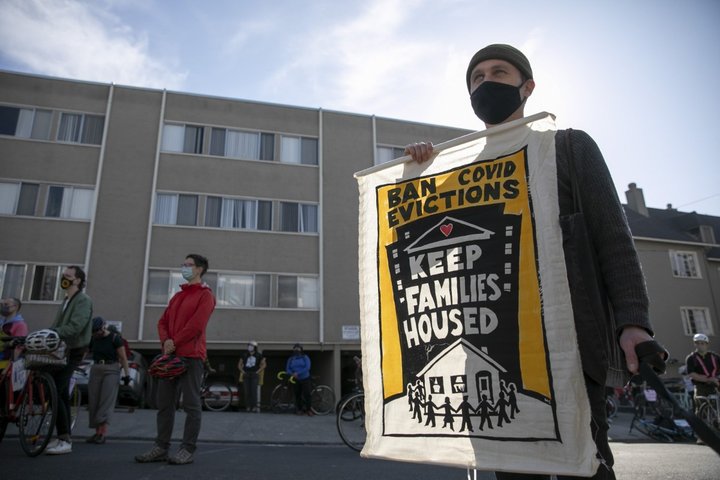
Oakland resident Andrew Rosenburg holds up a banner while protesting rent evictions during the pandemic on Dec. 5, 2020 in Oakland. Photo by Anne Wernikoff for CalMatters
###
As the state faces its most stringent business shutdowns since spring and as moratoriums protecting many from eviction threaten to sunset, California lawmakers have started debating more protections for vulnerable renters and landlords whose finances were affected by the pandemic’s deepening economic crisis.
Now, a new study of 44 states that enacted eviction moratoriums links evictions to an increase in coronavirus deaths and cases.
“We wanted to know whether these moratoriums could protect people from COVID,” said Kathryn Leifheit, lead author on the study and researcher at UCLA’s Fielding School of Public Health. And they do, the study found. “But the flip side of that is, when you get rid of them, people experience more COVID cases and deaths.”
Nationwide, the lifting of moratoriums resulted in an extra 365,200 to 502,200 coronavirus cases and between 8,900 and 12,500 more deaths, according to the study by researchers from UCLA’s Fielding School of Public Health and the John Hopkins University, Bloomberg School of Public Health, among others. “Any deaths would be upsetting, but these are large estimates,” Leifheit said. “You’re talking about big numbers.”
The study, pending peer review but published due to the urgency of the research, followed from March to September the 44 U.S. states that enacted eviction moratoriums. Researchers then compared data from the 27 states that lifted protections to the 17 states that kept them — including California, where existing protections are currently set to expire on Jan. 31. The federal moratorium ordered by the Centers for Disease Control expires on Dec. 31.
“The nature of the pandemic is temporary but the consequences for people’s lives can be lifelong, COVID can lead to death,” said Julia Raifman, co-author of the study and assistant public health professor at Boston University. “But also I think that children might never recover from the state of homelessness.”
After 16 weeks, states that had lifted their moratoriums had roughly twice as many cases than those that hadn’t, and their coronavirus mortality rates jumped: they were 5.4 times higher than those who had kept them, the study found. Texas, whose population is closest to California’s but which lifted its moratorium mid-May, would have had at least 120,650 less cases and 4,456 less deaths if moratoriums remained, the study found.
“We wanted to know whether these moratoriums could protect people from COVID. But the flip side of that is, when you get rid of them, people experience more COVID cases and deaths.”
— Kathryn Leifheit, researcher at ucla’s fielding school of public health
“Rates of COVID compared to now were relatively lower back then,” Leifheit said. “Now, thinking of January, we’re talking of a bunch of states losing those protections all at once and we’re talking of a phase of the pandemic where we’re getting 1 million cases a week.”
The researchers noted that not everyone who contracted the virus as a result of lifted moratoriums had necessarily been evicted. Rather, some of the additional cases and deaths were caused by what Madeline Howard, senior housing attorney at the Western Center on Law and Poverty, called a “ripple effect” of people moving in with friends and family, couch surfing, or crowding homeless encampments. “It’s not only about people affected by the evictions, it hurts the whole community,” said Howard.
“All of the additional exposure, it’s the opposite of shelter in place,” said Amie Fishman, executive director for Non-Profit Housing of Northern California.
While landlords — many of whom are also struggling to pay mortgages and bills — are asking for caution in extending renters’ protections, some lawmakers in California are pushing to extend protections for renters. Assemblymember David Chiu, D-San Francisco, this week introduced two bills proposing rental relief for those facing rent-related debt and extending the current statewide moratorium until December of next year. The state’s current moratorium protects renters from eviction if they provide a declaration that they were financially affected by the pandemic and pay a quarter of their rent.
“People have lost work because of the pandemic, and that is concentrated in low-income households who were already living paycheck to paycheck,” Raifman said. “I don’t think these people would be facing evictions otherwise.”
“And then the problem of the few becomes the problem of the many,” Leifheit said.
###
This article is part of the California Divide, a collaboration among newsrooms examining income inequality and economic survival in California.
CALmatters.org is a nonprofit, nonpartisan media venture explaining California policies and politics.
CLICK TO MANAGE